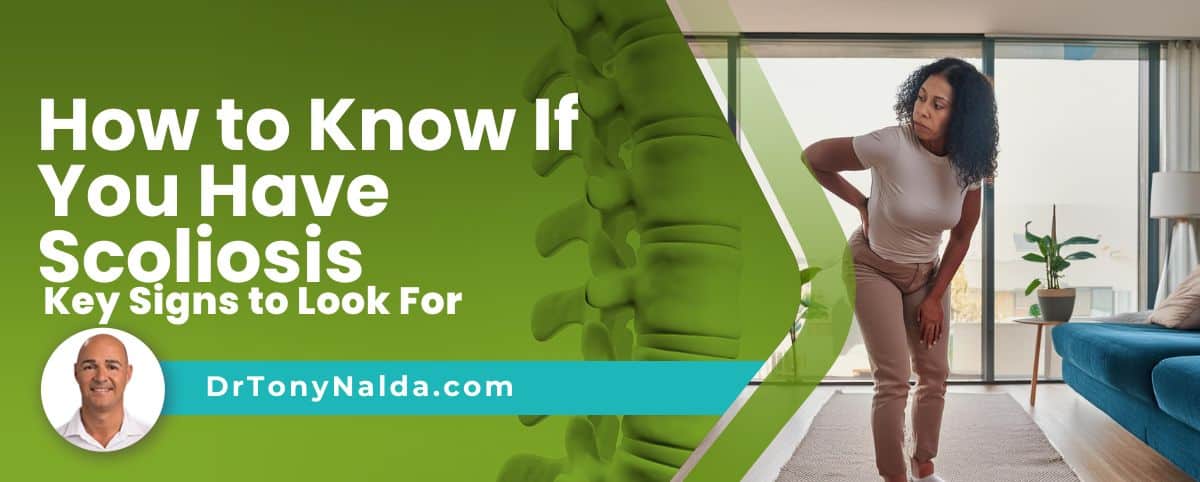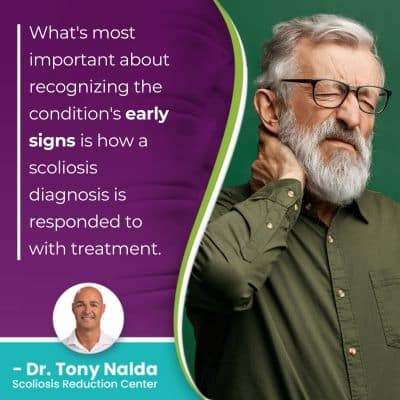How to Know if You Have Scoliosis: Key Signs to Look For

Knowing if you have scoliosis means knowing whether or not you need treatment, and regardless of condition type or severity, all cases of scoliosis can benefit from treatment. As a progressive condition, the nature of scoliosis is to get worse over time, so even if diagnosed as mild, there are no guarantees that the scoliosis will stay mild, hence the importance of proactive treatment.
The only way to know if you have scoliosis is to be assessed and diagnosed by a medical professional, and this involves a physical examination and a scoliosis X-ray; however, knowing key signs to look for can lead to early detection. Uneven shoulders and hips are often the earliest signs.
A scoliosis X-ray is needed to officially diagnose scoliosis; let's start with why.
Table of Contents
Scoliosis X-ray
Scoliosis causes the spine to develop an unnatural spinal curve; the curve will bend unnaturally to the side and also rotate, and the twisting element makes scoliosis a complex 3-dimensional condition.
The spine losing one or more of its natural and healthy curves means the spine is not aligned as it should be, and this means the spine, its surroundings, and the entire body is being exposed to a lot of uneven forces.
The spine's natural curves make it stronger, more flexible, and better able to absorb and distribute mechanical stress during activity, and as the spine and brain work together to form the body's central nervous system, spinal conditions can cause a wide range of effects.
Scoliosis is diagnosed through a combined physical examination that includes taking the patient's family history and medical history, asking the patient to bend forward and examine their spine.
A scoliosis X-ray is needed to fully see what is happening in and around the spine, to confirm the rotational component, and to determine the patient's Cobb angle measurement.
A patient's Cobb angle measures how tilted the unnaturally-tilted vertebrae are and classifies conditions based on severity.
The higher the Cobb angle, the more severe the condition, and treatment plans are shaped around condition severity: mild scoliosis, moderate scoliosis, severe and very severe scoliosis.
A scoliosis X-ray tells me everything I need to know about a patient's condition so treatment plans can be fully customized.
Early Signs of Childhood Scoliosis
 The signs of scoliosis can be subtle and difficult for anyone, other than a specialist trained in what to look for, to notice.
The signs of scoliosis can be subtle and difficult for anyone, other than a specialist trained in what to look for, to notice.
With awareness of the condition's early signs, however, the need to seek medical assessment can be discovered earlier so it can help with early detection, and when a condition is diagnosed while still mild, there are a number of treatment benefits.
The milder scoliosis is at the time treatment is started, the better, but the benefits of early detection are only available to those who respond with a proactive treatment plan.
In cases of childhood scoliosis, the most common symptoms of scoliosis are postural changes, and this is due to the condition's uneven forces disrupting the body's overall symmetry.
Often, it's uneven shoulders and hips that are the earliest sign of scoliosis in children, and additional postural changes can include:
- Head uncentered over the torso
- One shoulder blade protruding more on one side than the other
- An uneven eye line
- The development of a rib cage arch
- Uneven arms and legs
As the condition's uneven forces disrupt the body's symmetry, its center of gravity is also shifting, causing changes to balance, coordination, and gait.
The earliest sign of scoliosis in adults is pain because scoliosis becomes a compressive condition once skeletal maturity has been reached.
As scoliosis progresses, these effects get more noticeable, which is why most of my patients are diagnosed with moderate scoliosis; it's often not until mild scoliosis progresses to become moderate that its signs are noticeable enough to lead to assessment and diagnosis.
So if you have noticed one or more of the aforementioned postural changes in a child, this doesn't guarantee a scoliosis diagnosis, but it does warrant further testing, particularly as growth triggers progression.
Growth and Progression
The signs of scoliosis tend to become more overt over time and this is because as a progressive condition, the nature of scoliosis is to become more severe.
The most common type of scoliosis to affect all ages is idiopathic scoliosis, and this type has no known cause, and adolescent idiopathic scoliosis, diagnosed between the ages of 10 and 18 is the most prevalent type overall.
Approximately 80 percent of known cases are diagnosed as idiopathic scoliosis, and the remaining 20 percent are associated with known causes: neuromuscular scoliosis, congenital scoliosis, and degenerative scoliosis.
While we don't know what causes the majority of scoliosis cases to develop initially, we do know how to respond with treatment, and we do know what triggers them to progress: growth.
Adolescents are the most at risk for rapid progression because of the rapid and unpredictable growth spurts associated with puberty, so a focus of childhood scoliosis treatment is on counteracting the condition's progressive nature by reducing the curvature of the spine and holding the reduction, despite the constant trigger of growth.
What's most important about recognizing the condition's early signs is how a scoliosis diagnosis is responded to with treatment.
What to Do if You Know You Have Scoliosis
So if you, or someone you love, has recently been diagnosed with scoliosis, the most important decision to be made is how to treat it; different treatment approaches will shape long-term spinal health differently, and the spine's health and function are key factors in maintaining quality of life.
There are two main ways to treat scoliosis, with or without surgery, and spinal fusion surgery is a costly, invasive, and risky procedure that successful conservative treatment can help avoid the need for.
Spinal fusion surgery can straighten a bent spine, but the way it does so, by fusing the curve's most-tilted vertebrae into one solid bone and attaching metal rods to the spine can cost the spine in terms of its flexibility, range of motion, and strength.
A fused spine is weaker and more vulnerable to injury, and this can lead to activity restrictions in some patients: another factor that can affect quality of life.
Conservative nonsurgical scoliosis treatment offers a more natural alternative that prioritizes maintaining as much of the spine's natural strength and function as possible, and the reality is that many patients don't need scoliosis surgery.
 Here at the Scoliosis Reduction Center, an integrative treatment approach is applied so patients benefit from accessing multiple different types of treatment under one roof, and when apportioned accordingly, the treatments compliment one another and can impact conditions on every level
Here at the Scoliosis Reduction Center, an integrative treatment approach is applied so patients benefit from accessing multiple different types of treatment under one roof, and when apportioned accordingly, the treatments compliment one another and can impact conditions on every level
Through condition-specific chiropractic care, the curve's most-tilted vertebrae are adjusted back into alignment with the rest of the spine, and when combined with physical therapy that can strengthen the spine's surrounding muscles for better support and stabilization, this can improve the spine's structure and balance.
Corrective bracing is particularly effective on spines that are still growing so can be a helpful facet of treatment for childhood scoliosis, and for adults, bracing is used more for short-term pain management and increasing the spine's stability.
Rehabilitation is also important because as a progressive condition, while scoliosis can be highly treatable, it's incurable; treatment is more about how best to manage an ongoing condition for the best quality of life.
Conclusion
While there are never treatment guarantees, early detection, when responded to with proactive treatment, has a number of treatment benefits.
As scoliosis progresses, the spine gets increasingly rigid, making it less responsive to treatment and making it difficult for some patients to perform key therapeutic exercises as part of treatment so starting treatment prior to significant progression having already occurred means treating a spine that's more flexible and responsive.
In addition, in most cases, once condition effects become more noticeable, they are more established and difficult to improve/reverse; it's more effective to proactively work towards counteracting progression and increasing effects than it is to attempt to reverse them once they're established.
Knowing you have scoliosis means getting an official assessment and diagnosis from a medical professional, and when it comes time to treat scoliosis, a scoliosis specialist is highly recommended; the complex nature of scoliosis is beyond the scope of general medical care.
Scoliosis treated early in its progressive line is associated with success, and untreated scoliosis is associated with continued progression, severe cases, and the development of complications.
Scoliosis is a sideways curvature of the spine, and knowing the condition's early signs can lead to early detection and intervention, putting patients on a potential path towards treatment success.
Dr. Tony Nalda
DOCTOR OF CHIROPRACTIC
After receiving an undergraduate degree in psychology and his Doctorate of Chiropractic from Life University, Dr. Nalda settled in Celebration, Florida and proceeded to build one of Central Florida’s most successful chiropractic clinics.
His experience with patients suffering from scoliosis, and the confusion and frustration they faced, led him to seek a specialty in scoliosis care. In 2006 he completed his Intensive Care Certification from CLEAR Institute, a leading scoliosis educational and certification center.
About Dr. Tony Nalda
 Ready to explore scoliosis treatment? Contact Us Now
Ready to explore scoliosis treatment? Contact Us Now





